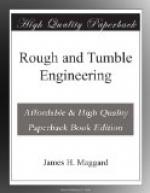In selecting a new gauge you will be better satisfied with a gauge having a double spring or tube, as they are less liable to freeze or become strained from a high pressure, and the double spring will not allow the needle or pointer to vibrate when subject to a shock or sudden increase of pressure, as with the single spring. A careful engineer will have nothing to do with a defective steam gauge or an unreliable safety valve. Some steam gauges are provided with a seal, and as long as this seal is not broken the factory will make it good.
FUSIBLE PLUG
We have told you about a safety valve, we will now have something to say of a safety plug. A safety, or fusible plug, is a hollow brass plug or bolt, screwed into the top crown sheet. The hole through the plug being filled with some soft metal that will fuse at a much less temperature than is required to burn iron. The heat from the firebox will have no effect on this fusible plug as long as the crown sheet is covered with water, but the moment that the water level falls below the top of the crown sheet, thereby exposing the plug, this soft metal is melted and runs out, allows the steam to rush down through the opening in the lug, putting out the fire and preventing any injury to the boiler. This all sounds very nice, but I am free to confess that I am not an advocate of a fusible plug. After telling you to never allow the water to get low, and then to say there is something to even make this allowable, sounds very much like the preacher who told his boy “never to go fishing on Sunday, but if he did go, to be sure and bring home the fish.” I would have no objection to the safety plug if the engineer did not know it was there. I am aware that some states require that all engines be fitted with a fusible plug. I do not question their good intentions, but I do question their good judgment. It seems to me the are granting a license to carelessness. For instance, an engineer is running with a low gauge of water, owing possibly to the tank being delayed longer than usual, he knows the water is getting low, but he says to himself, “well, if the water gets too low I will only blow out the plug,” and so he continues to run until the tank arrives. If the plug holds, he at once begins to pump in cold water, and most likely does it on a very hot sheet, which of itself, is something he never should do; and if the plug does blow out he is delayed a couple of hours, at least, before he can put in a new plug and get up steam again. Now suppose he had not had a soft plug (as they are sometimes called). He would have stopped before he had low water. He would not even have had a hot crown sheet, and would only have lost the time he waited on the tank. This is not a fancied circumstance by any means, for it happens every day. The engineer running an engine with a safety plug seldom stops for a load of water until he blows out the plug. It frequently




